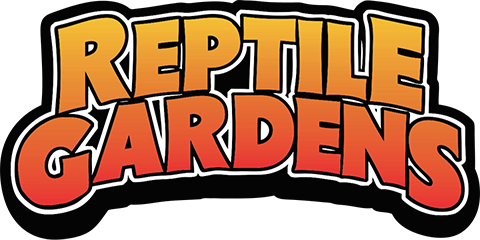Bird Brains: Training Birds and Birds of Prey
Have you ever had someone call you a bird brain? Usually that means that they are saying you're not too smart. Yet, sometimes we use an owl as a symbol for being wise. Mixed signals, right? I think this is a pretty good example of exactly how little we know about what birds are thinking.
Unfortunately, birds can't tell us what they are thinking, so we can't be 100% certain about how they feel and what they want. However, that does make working with animals more fun. Gotta love a challenge! Instead of listening to them tell us what they think, we have to learn to pick up on their subtle hints.
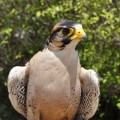 Our Lanner Falcon, Gypsy
Our Lanner Falcon, GypsyIn my experience, the most successful form for training both birds and birds of prey is positive reinforcement. Simply put, whenever they do a desired behavior, they receive a reward. Whenever they do an unwanted behavior, they receive nothing. Pretty straightforward, but not always so easy to execute. When people "train" their children or their cats or dogs, some type of punishment is often part of the training. When working with birds, punishment either does not affect them or far worse, it can cause them to become confused or aggressive. In essence, it really doesn't work well for them.
The birds we have at Reptile Gardens, both birds and birds of prey, are all trained using the positive reinforcement method and it is highly successful...for the most part. Have you ever looked back at something you have done and just thought, "Ooops!"? Well, that has happened many times in the bird department. We are training birds to do both show behaviors and general husbandry behaviors. Occasionally things don't go as planned.
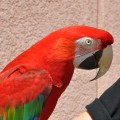 Ruby, the Green-winged Macaw
Ruby, the Green-winged MacawWhile in the parrot room, it happens quite often that one parrot will start to scream and all the others will follow suit. When that happens, the sound quickly becomes unbearable to listen too. After being in the parrot room for hours, scrubbing cages and listening to that sound, there are many things that you might want to yell to get them to stop. We aren't sure when someone decided to shout "Stop!" while the parrots were screaming, but we are pretty sure someone must have. This is because our lovely, Green-winged Macaw, Ruby, now adds to the screaming with her own high pitched "STOP!" Of course, this does not make the parrots stop, it just adds to their loud chorus. That is not a behavior that we would like but has been trained.
Speaking of screaming, some birds like our Moluccan Cockatoo, Queenie, has a less than pleasant habit of loudly announcing her presence while in the Safari Room of our Sky Dome. Often her yells sound like she is in peril so it causes people to go check her out to
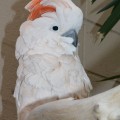 Our Moluccan Cockatoo, Queenie
Our Moluccan Cockatoo, Queeniemake sure she is okay. Parrots, as many pets do as well, tend to take any kind of attention (positive or negative) as a reward. So, whenever someone would go look at Queenie she would see it as prize for her screaming. Now it seems that if she is bored and wants someone to come keep her company, she will yell to her heart's delight and magically a person will appear! It's really disturbing when our birds train us! Now we have to try our hardest to ignore that behavior and hope it eventually goes away.
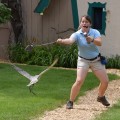 Our Lanner Falcon, Gypsy
Our Lanner Falcon, GypsyTraining our birds of prey is very similar to how we train our other birds like parrots, except for the fact that their only reward is food. Raptors really don't seem to care if you give them praise or not. They are just there for the delicious rat and mouse pieces. Our Lanner Falcon, Gypsy, flies on stage while chasing a prop called a lure. The basic idea is that we throw the lure towards the falcon and pull it away at the last second so that he has to come back around again to try to catch it. This action is much like what a falcon hunting prey in the wild experiences. We do this 2 to 4 times depending on how Gypsy is reacting to the lure.
I'm sure it is pretty easy to see how things can go wrong. You have to be able to give him the lure close enough to the lure so that he feels like he might catch but not so close that you hit him with it. There is a very fine line between those two things! Either he gets the lure so fast that he barely flies around the audience, or he decides that you aren't actually going to give him the lure so he flies away. Both options are no fun. That is why, when you swing the lure perfectly, you want to do a little jig!
So whether it's a bird of prey like falcon flying towards your face at top speeds or a parrot screaming happily in your ears, training is very specific and important. Oh, and next time some one calls you a bird brain, you can tell them how complex and awesome bird's brains are and that the joke is on them!
HA!
Except for those owls who, frankly, don't have a whole lot going on inside their skulls. Sorry owl lovers.
Teresa Aldrich
Assistant Curator of Birds
